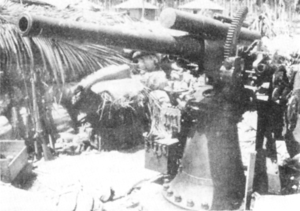8 cm/40 3rd Year Type naval gun
| 8cm/40 3rd Year Type naval gun | |
|---|---|
|
An 8cm/40 3rd Year Type gun captured at Guadalcanal | |
| Type | Naval gun |
| Place of origin | Empire of Japan |
| Service history | |
| In service | 1914–45 |
| Used by | Imperial Japanese Navy |
| Wars |
World War I World War II |
| Production history | |
| Designed | 1914 |
| Number built | 69 (plus possibly spares) |
| Specifications | |
| Weight | 600 kilograms (1,323 lb) |
| Barrel length | 3,048 millimeters (10 ft 0 in) (bore length) |
|
| |
| Shell | Fixed |
| Shell weight | 5.67–5.99 kilograms (12.5–13.2 lb) |
| Caliber | 7.62-centimeter (3.0 in) |
| Breech | sliding breech block |
| Carriage | pedestal mount |
| Elevation | -5° - +75° |
| Traverse | 360° |
| Rate of fire | 13-20 rounds per minute |
| Muzzle velocity | 670–685 meters per second (2,200–2,250 ft/s) |
| Maximum firing range | 10,800 meters (11,800 yd) |
|
| |
| Flight ceiling | 5,400 meters (5,900 yd) (eff. ceiling) |
The 8cm/40 3rd Year Type naval gun was a Japanese naval anti-aircraft gun introduced during World War I. Although designated as 8 centimeters (3.15 in), its shells were actually 76.2 millimeters (3 in) in diameter.
It was installed on the Sendai-class cruiser, Chikuma-class cruiser, Tenryū-class cruisers, Kuma-class cruisers, Nagara-class cruisers, Japanese cruiser Yūbari, Ise-class battleships, Fusō-class battleships, Japanese aircraft carrier Hōshō, Japanese submarine tender Komahashi, Jingei-class submarine tenders.
During Pacific War the gun was thoroughly obsolete, relegated to secondary duties on smaller ships like Ning Hai-class cruisers, Japanese minelayer Itsukushima, Akagi Maru-class Armed merchantmens, and especially gunboats. Some guns were given to civil air defense in the Southern Japan.
Notes
References
- Campbell, John (1985). Naval Weapons of World War II. Annapolis, MD: Naval Institute Press. ISBN 0-87021-459-4.
- This page incorporates material from Japanese Wikipedia page ja:四十口径三年式八糎高角砲, accessed 22 January 2016
External links
| Wikimedia Commons has media related to Type3 8cm AA Gun. |
